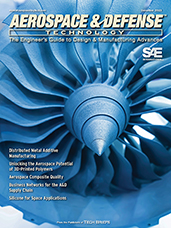Aerospace & Defense Technology
December 2023
- How Distributed Metal Additive Manufacturing Can Add a Surge to Military Supplier Strategies
- Ensure Aerospace Composite Quality with Force Measurement, Material Testing
- How Business Networks Can Help Stabilize the A&D Supply Chain
A blueprint for modernizing the supply chain for greater connectedness and collaboration. - Unlocking the Potential of 3D-Printed Polymers in Aerospace and Defense
- How to Select the Right Silicone for Space Applications
- Key Measurements to Maintain Performance of Critical Electronic Systems on Military Aircraft and Warships
- Physicists Develop a New Type of Antenna
- Towards Sustainable Recycling of Epoxy-Based Polymers: Approaches and Challenges of Epoxy Biodegradation
Composites are especially important for the development and implementation of sustainable technologies such as wind power, energy-efficient aircrafts, and electric cars. Despite their advantages, their non-biodegradability raises challenges for the recycling of polymer and composites in particular - Composite Repair Engineering Case Studies for U.S. Army Aerostructures
The U.S. Army fields a multitude of aircraft mission design series (MDS) developed by several different original equipment manufacturers with varying mission requirements and flight profiles. The structural analysis in this work assumes the materials, tooling, skillsets, and capabilities are organically available and proper at the repair location. - Ensure Aerospace Composite Quality with Force Measurement, Material Testing
Ice prediction capabilities for Unmanned Aerial Systems (UAS) is of growing interest as UAS designs and applications become more diverse. This report summarizes the current state-of-the-art in modeling aircraft icing within a computational framework as well as a recent U.S. Army DEVCOM AvMC effort to evaluate ice prediction models for current use and future integration into the Computational Research and Engineering Acquisition Tools and Environments (CREATE) Air Vehicle (AV) framework. - Modeling and Experimenting with 2D Materials for CMOS Type Devices and Digital Integrated Circuits
Two-dimensional transition metal dichalcogenides (2D-TMDs) have been proposed as novel optoelectronic materials for space applications due to their relatively light weight. MoS2 has been shown to have excellent semiconducting and photonic properties. Here, we report the effect of gamma irradiation on the structural and optical properties of a monolayer of MoS2.
Related Topics:

